The traditional craft documented in Howard Chapelle’s books are well known, but a number of his drawings are tucked away in the Smithsonian Institution. Among the turn-of-the-century East Coast workboats in their files, catalogued as HIC303, is a handsome 18′ crabbing skiff. It has many of the characteristics associated with working skiffs used by Chesapeake Bay crabbers of the era: a shallow deadrise hull, a large skeg and centerboard, a transom-hung rudder, multiple thwarts, a foredeck with washboards down the sides, and a low coaming around the cockpit.
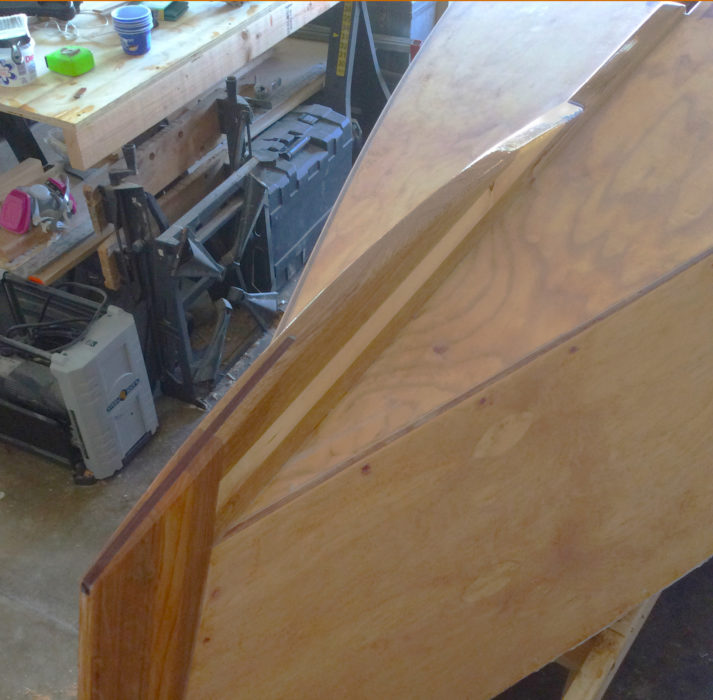 Christopher Walker
Christopher WalkerThe gripe is a skeg-like fin on the bow. It helps balance the skiff while under sail in thin water with the centerboard up.
The skiff also has a gripe, a skeg-like appendage attached to the stem meant to keep the bow from wandering after tacking and allow sailing shallow water with the board up. The sailing rig has a freestanding mast with a sprit boom and a curved bowsprit. The leg-o’-mutton main and the jib have a combined area of around 151 sq ft with 111 sq ft in the main and 40 for the jib.
In Chapelle’s drawings, he provides no measure of the boat’s weight, but he included plank thicknesses for the oak, pine, and cedar used throughout the original’s construction, making it evident that the crabbing skiff must have been quite robust. There are some unusual things in the plans. For example, the centerboard trunk is canted at each end, sloping down at the aft end but also sloping down toward the bow at the forward end. The plans indicate two locations for the centerboard pin, about 5″ apart, but no explanation of the purpose of the options.
The skiff was my first build, and when I was looking for a design, I wanted not only a family boat for my wife, a little one on the way, and two dogs for daysailing and camp-cruising, but also one that looks nice and sails well. I found the HIC303 on the WoodenBoat Forum. Though the design was for traditional construction, all the hull surfaces were developable curves, which got me thinking about building it in plywood. I didn’t have the time, money, or experience for a traditional build. I also lacked a wet slip for a traditionally built boat to keep its seams tight—I am in the military and move frequently, so anything I’d build would have to live on a trailer.
I built GOLDBUG in my garage over the course of two-and-a-half years, starting when my son was born and then working mainly on weekends. I used Douglas-fir marine plywood for the hull: 1/2″ for the bottom, 3/8″ for the topsides, and 3/4″ for the transom. The deck is 3/8″ okoume. All of the plywood was covered with 6-oz fiberglass and epoxy. The skeg is a big timber with oak making up the biggest piece in Chapelle’s drawings; I built it up with 1-1/2″ Douglas-fir to keep it light and added a 3/4″ white oak shoe and trailing edge to take the inevitable bumps of the trailer and grounding out on rocks. I also lightened the 23′11” mast by making it hollow—bird’s-mouth from vertical-grain fir—rather than the solid spruce indicated. The bowsprit is three layers of clear, 3/4″ vertical-grain fir epoxy laminated in a curve. Rubrails and toerails are white oak. I used cedar deck boards to make the cockpit coaming.
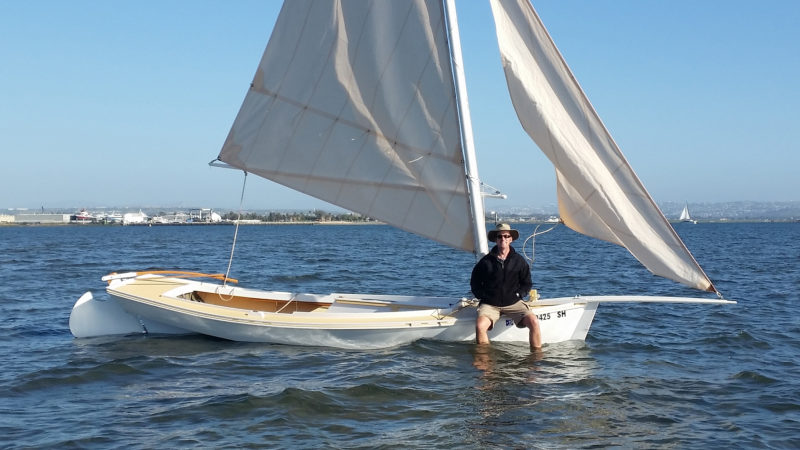 Meg Walker
Meg WalkerThe 6′ 8″ bowsprit extends 4′ 3″ forward of the stemhead. The jib’s leech is cut to clear the forward end of the main’s sprit boom when coming about.
It was important to me to have a boat that looks good with a workboat finish. With a sensitive little one riding shotgun, if he dropped a bucket of seashells over a nice varnished thwart or ground sand into a bright sole, I didn’t want to get upset and ruin his sailing days. Cost was also a factor, so I steered away from pricey marine-grade finishes. GOLDBUG wears three coats of acrylic exterior house paint, inside and out. It has turned out to be fantastic stuff—very durable and tremendously easy to touch up and clean up afterward. Three years after launching, the paint still looks great.
I am not an engineer—no calculations were harmed in the building of GOLDBUG—but I grew up on small sailboats, raced extensively, and feel I have a good sense of forces and how they’re distributed on small boats. I altered the HIC303 design to include one thwart instead of the two specified in the plans. I placed my thwart at the aft end of the centerboard trunk to provide lateral support to the trunk while using the trunk to support the middle of the thwart. This opened the interior significantly for a cooler, a tent as well as a toddler, a dog, and the miscellaneous gear that comes with them.
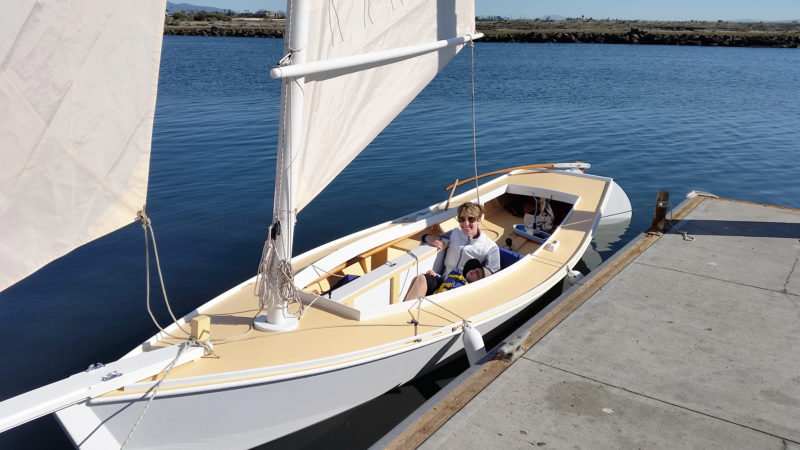 Christopher Walker
Christopher WalkerThe centerboard trunk in the original crabbing skiff was left partially open and the board extended above the trunk when retracted. Capping the trunk and modifying the board keeps the interior drier in a seaway.
To brace the forward end of the trunk, I butted it to the one-piece frame that supports the aft edge of the foredeck. The plans show an open frame made of multiple pieces, none of which support the centerboard trunk. The trunk of the original was open at the top with the board extending above it; I lowered it and enclosed the top, making it a nice place to sit and watch the shoreline pass by.
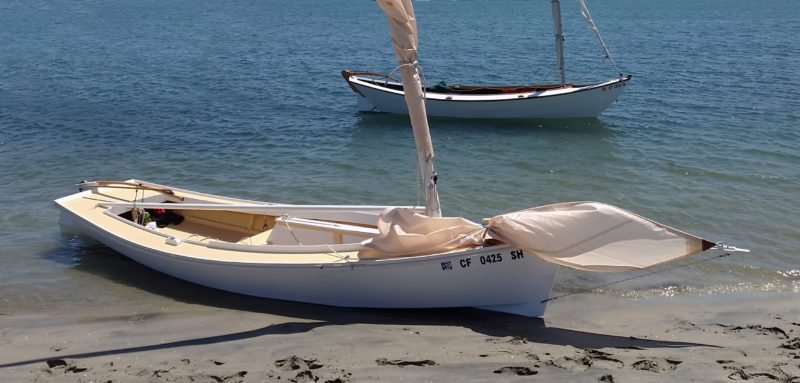 Christopher Walker
Christopher WalkerChapelle’s plans have the side decks extending to the transom and sternsheets instead of an aft deck.
I also decked GOLDBUG’s stern, filling in the gap between side decks all the way to the transom. There was no seating at the stern in the original plans, and sitting at the stern would put the boat out of trim while the covered space I’ve added there comes in handy for stowing gear.
The mast steps through the foredeck, which is reinforced underneath with Douglas-fir 1x2s. The bowsprit is about 6-1/2′ long and has a mortise that seats on top of the stem with a heel secured against the bit. The bobstay keeps it secure and provides an easy, quick way to remove the sprit.
It takes me 20 minutes, working alone, from the time I pull into the parking lot to having the boat afloat with the sails raised and ready to shove off. At the dock it is tender initially, though stepping into the center is hardly necessary as long as one’s weight is anywhere on the bottom and not on the side decks. Underway it stiffens up as it heels even though I have no ballast beyond 5 lbs of lead in the board to sink it. Breaking it down at the end of the day takes the same amount of time as setup, though when folks wander over to take a gander it takes longer.
The oak gripe and stem take beaching beautifully. GOLDBUG, with its modifications and plywood construction, weighs around 350 lbs and is easy to launch, recover, and drag up on a beach. She draws about 4″ with no one aboard. With the three of us, a dog, and an afternoon’s gear, she still draws less than 1′ with the board up.
The skiff reaches well even with the board up, thanks to the balanced lateral resistance provided by the skeg and gripe. On a reach and measuring speed on a GPS, she reaches at 6.5 knots in 12–15 knots of wind with the board halfway up. She beats to windward very well. In all wind conditions I trim the main without purchase (plans call for a 2:1 purchase), but I do use one block with a ratchet mounted in the keelson to have the sheet coming to me at a more comfortable angle. Mounted in the keelson, just forward of the block, is a cam cleat into which I can cleat the mainsheet with my foot while sitting up on the deck. I feel the 1:1 pull without purchase gives me better feedback as to how much stress is on the rig.
Underway, the helm is well balanced and exhibits just the right amount of weather helm as she heels. The stern lifts to a following sea, and the ample skeg keeps the skiff on track as if on rails . In theory, the gripe could trip the boat with a large following swell by not allowing the bow to slide laterally if the skiff did try to broach. But I have yet to experience anything like this, and the conditions for which she was originally designed include short, stiff chop rather than long, rolling swells.
The gripe does slow tacking—one has to avoid rapid stop-to-stop tiller throws. The skiff she won’t spin in its own length, one must think ahead when maneuvering in close. It ghosts nicely in light air; ideal wind seems to be 8–12 knots. If strong winds are forecast, the first reduction in sail is going without the jib. Next is the reefpoint in the main. She sails well under all configurations, and adjusting centerboard depth balances her nicely while maintaining windward performance. When I sail without the jib, I remove the jib halyard from the peak of the jib and secure it to the anchor point for the jib’s tack at the end of the bowsprit. With the halyard serving as a forestay, it counters the force created by the main, and the mast bends less.
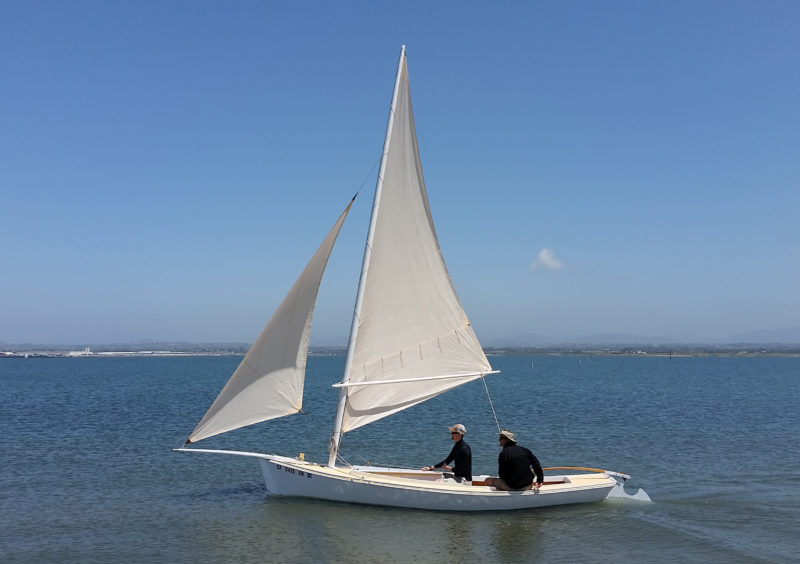 Meg Walker
Meg WalkerThe 151 sq ft of sail can get the skiff moving at a brisk 6-1/2 knots in 12 to 15 knots of wind.
When the wind dies or I find myself short on patience or in a foul current, GOLDBUG rows well, though she is more a sailboat that can be rowed. I bought an electric trolling motor, and it pushes her very nicely—though I have yet to use it much, as it looks tacky on the back of the boat. Truth be told, I have never used the oars or trolling motor except to try them out, since GOLDBUG moves in the lightest of breezes.
The 18′ Crabbing Skiff is an easy boat to sail with a very simple rig. Built of plywood, it is easy to build and goes well in all conditions, as long as one can avoid being overpowered. It is relatively dry given its lower freeboard, and the crew’s proximity to the water contributes to a fun sensation of speed. GOLDBUG’s freeboard also makes it easy for a toddler to drag his toes in the water.![]()
Chris Walker is an Air Force officer and combat rescue helicopter pilot. He grew up sailing on Mobile Bay, Alabama, and lakes across the central Midwest. Boats have always been a large part of his life, and racing was his focus for a long time. After his fifth deployment to Afghanistan, he began looking for a design to build. He found the time he spent in the garage building GOLDBUG to be a great source for thought, reflection, and problem-solving. He built GOLDBUG while assigned in San Diego and is currently assigned to Fort Leavenworth, Kansas. Back on the lakes where he raced growing up, he finds spending time on GOLDBUG with his wife and four-year-old son far more enjoyable than racing ever was. This summer they’ll move to Virginia near the Chesapeake, and Chris is looking forward to sailing GOLDBUG in the waters she was designed for.
Crabbing Skiff Particulars
[table]
Length/18′ 7.5″
Beam/5′ 4.25″
Draft/11″
Sail area/151 sq ft
[/table]
Plans for the Crabbing Skiff are available from the Smithsonian Institution. There are three sheets for HIC303: Lines with offsets, construction plan, and sail/spar plan. Each sheet costs $10; all three will be $30 plus $5 for shipping and processing. All orders are handled by mail. Request HIC303 and enclose a check or money order payable to the Smithsonian Institution. Credit card or PayPal orders are not accepted. Foreign orders require check or international money order in U.S. funds, with airmail available for an additional $5.00.
Ship Plans
Smithsonian Institution
PO Box 37012
NMAH 5004 / MRC 628
Washington, DC 20013-7012 USA
Is there a boat you’d like to know more about? Have you built one that you think other Small Boats Monthly readers would enjoy? Please email us!


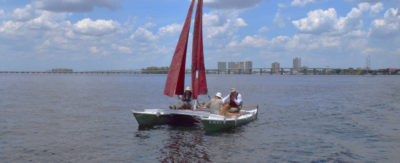
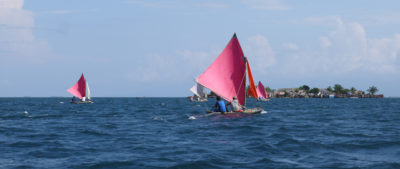
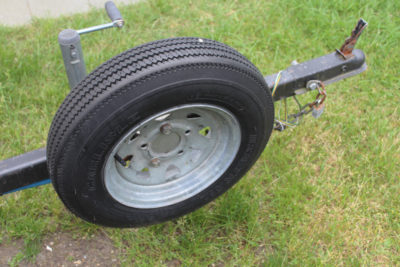
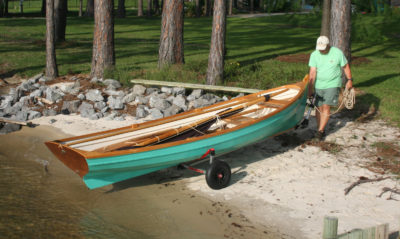
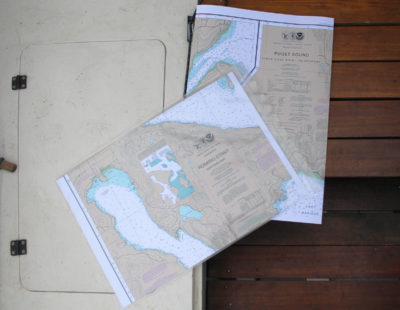
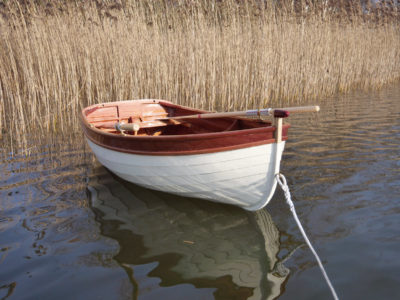
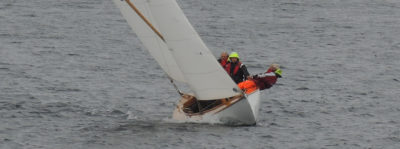
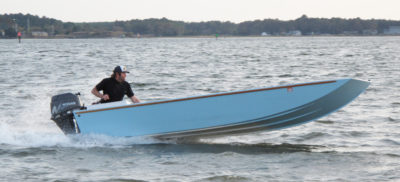
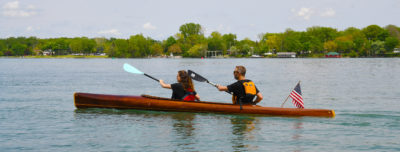

Great Job. I’ve used house paint also on a 18′ sharpie I built a few years ago. My reasons were a little different: #1 I’m cheap, #2 She’s a work boat design, nothing fancy, fancy paint and varnish just wouldn’t fit in, and #3 A ding here, a gouge there, just slap some more paint on. Keep sailing.
Chris,
I built the same boat in 1990 and have used it every season since. Mine is traditional build almost exactly as in the plans. I modified the deck and seating almost exactly as you did. Your description of the sailing qualities is exactly the way I would describe my boat. It is a wonderful boat in which I raised my kids. You did a beautiful and practical job. Unfortunately I am getting too old for so many boats and am looking for a good home for my 28-year-old skiff. It is tough because the traditional build requires keeping the boat in the water. Yours is the only other HIC303 that I know of.
Nice work and best of luck,
Tom
Tom,
This is way late as I didn’t know one could post comments on these. If you read this, thank you for the comments. I saw your boat on the internet and it’s what got me locked onto this design after having “settled” a couple times on other designs. Were I not moving around all the time, I might like to try to build another with lessons learned from this first one. It’s a great design and I’ve really enjoyed it. After 3 years of use with zero maintenance, it’s still just great. The only thing I want to do this fall is put another coat of paint on the sole inside where shoes, anchors, coolers, and such slide around on the bottom.
Chris
I now have Tom’s boat and it’s still amazing to sail. Was a bit scared the first time I put it in the water how much it leaked…but after three days of a good soak its tight as a drum. I have raced log canoes for the last 27 years and am blown away by how much this rig and sailing her is so similar. I guess when the old timers that designed them got something right they stuck with it, no mater the size.
Tom, if you are still around, thank you for building such a wonderful traditional Chesapeake bay boat. She’s sailed and enjoyed in her native waters now.
Ed,
Where on the Chesapeake do you sail Tom’s old boat?
Chris,
Is the boat anchored in the background of the picture with your beached crabbing skiff in the foreground a Pete Culler design? (perhaps the vee-bottom, double-ended, beachboat “JAVA” and “CRUZ del SUR”)
Eric,
Not sure of the designer but it is a flat bottom dory. The owner purchased her and sails up and down San Diego bay. She’s very much a work boat finish and handles the conditions on the bay really nicely.